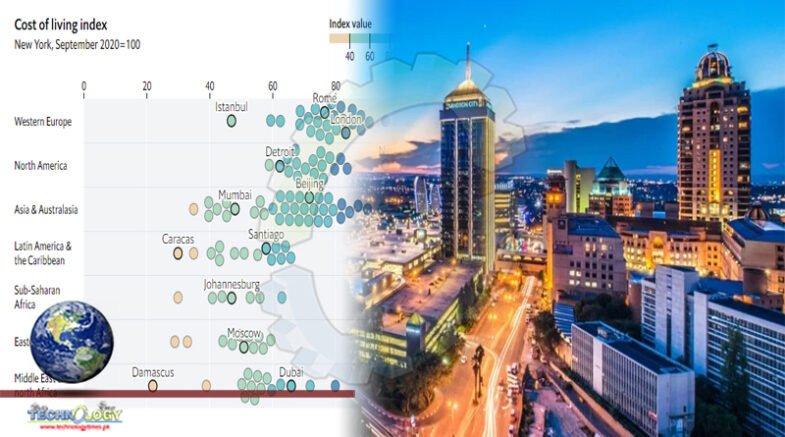The latest Cost of Living Index published by The Economist Intelligence Unit shows that the prices of 138 goods in about 130 major cities.

The latest Cost of Living Index published by The Economist Intelligence Unit shows that the prices of 138 goods and services in about 130 major cities as at September 2020, has risen by 0.3 points on average over the past year.
The Economist said that the data points to several fluctuations in the price of goods as a result of the Covid-19 pandemic, with prices – thus the cost of living – getting higher.
However, increases were not across the board. Of the 10 categories covered by the report, tobacco and recreation (including consumer electronics) have seen the biggest price increases since last year, while clothing prices have seen the steepest decline.
Price increases were due to currency volatility, supply chain problems, the impact of taxes and subsidies, and shifts in consumer preferences during the pandemic.
Local currency exchange-rate movement against the dollar caused many of the shifts in the global rankings, The Economist said, given that cities are compared using an index in which New York City is the base city.
“In general, currency weakness has followed the pandemic as it spread across the world from Asia to Latin America. By September 2020, when our survey was taken, currencies were weakest in the Americas and strongest in Western Europe,” it said.
Supply-chain problems affected price trends in the 2020 survey, with shortages of goods such as toilet roll and pasta fuelling price increases in some categories.
In certain cities, government actions drove price changes. Some countries imposed new price controls amid high demand from panic buyers. Others have raised taxes to offset revenue shortfalls.
Many countries have seen a sharp fall in disposable incomes, despite government support, however. Consumers have responded by increasing precautionary savings and slashing spending.
“Changes in lifestyles caused by the pandemic have also influenced prices—for example, stay-at-home shoppers have new views on the goods and services that they see as essential,” it said.
South Africa
South Africa is represented in the index by Pretoria and Johannesburg, which now settle in the 40 to 60 point range, meaning the cost of living in these cities is between 40% to 60% cheaper than New York.
Pricing trends in South Africa would run counter to some of those seen globally. For example, alcohol prices exhibited an upward trend, with demand shooting up as lockdown set in.
In South Africa, however, a long-term ban on alcohol pushed consumers away from legitimate alcohol sources, sinking traceable demand. A similar global trend was seen for tobacco products, which had the same fate as alcohol, locally.
Of note is how the cost of living in South Africa has fluctuated over the years. It is far cheaper to live in South Africa today – relative to New York – than it was a decade ago, when the index score for Johannesburg and Pretoria was at 80 to 100 (0% to 20% cheaper).
What lies ahead
According to the Economist, what lies ahead for 2021 will depend on the course of the pandemic.
“We expect many of the price trends to continue into 2021. With the global economy unlikely to return to pre-pandemic levels until 2022, spending will remain restricted and prices under downward pressure.
The research unit said that price-conscious consumers will prioritise spending on staples, home entertainment and faster internet access. Big-ticket items, as well as clothing and out-of-home recreation, will continue to struggle,” it said
“Laptop and smartphone prices will also bear the brunt of tariff wars, as will many items in the food basket. Imported goods will remain susceptible to currency fluctuations. We expect online sales to continue to expand their share of total retail sales in 2021.
However, even online retailers will struggle to find new sources of revenue and will rely on price competition to boost volumes,” it said.
Originally published at businesstech
